Honorable Mention #1: Fraying Omnipotence
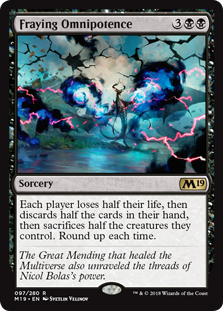 It only seems fitting – albeit coincidental – that the first card mentioned here relates to the Nicol Bolas story itself. Namely, the loss of his godlike planeswalker powers and his extensive planes-spanning machinations to regain his former stature. It’s a nice nod not only to the driving factor of the current timeline events, but it also decently encapsulates more than a few motes of the Magic story in general over the last 15 years.
It only seems fitting – albeit coincidental – that the first card mentioned here relates to the Nicol Bolas story itself. Namely, the loss of his godlike planeswalker powers and his extensive planes-spanning machinations to regain his former stature. It’s a nice nod not only to the driving factor of the current timeline events, but it also decently encapsulates more than a few motes of the Magic story in general over the last 15 years.
Of course, flavor is nice and all, but that’s not what gets it the first honorable mention here. That honor is due to its exceedingly Black effect of delivering mutual pain to everyone involved. The card itself is a more modern iteration of the classic card Pox, with two notable exceptions.
First, Fraying Omnipotence in many ways is more powerful than Pox, as players must sacrifice half their life, cards in hand, and creatures on the battlefield, rather than just a third. This card simultaneously can cripple players with high life totals, massive creature armies, or who may be sitting on a large array of cards in their hand. Or, you know, all of the above. True, just like Pox it hurts you too, but with such cards you’re usually casting them when you’re behind in some fashion anyway, so it’s likely to be considered acceptable losses.
Second, while Fraying Omnipotence costs two additional mana than Pox, it’s much easier to splash into multicolor decks, making it more useful to a larger percentage of players. Fraying Omnipotent also forgoes Pox’s most negative effect: land destruction. With this style of card you can instill illness upon your opponent without also losing your mana base in the process. Insult without as much of an injury, as it were.
Honorable Mention #2: Transmogrifying Wand
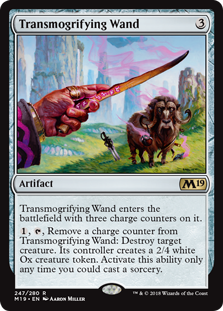 Anyone who has ever played a monocolored EDH deck knows that while the color’s strengths are magnified due to increased card options and more synergy, so too are the color’s weaknesses, as you are unable to contend with the various restrictions that each color brings. No one color can singlehandedly address every situation they encounter with equal success. Which is why many so many players turn to colorless options like artifacts and nonbasic land.
Anyone who has ever played a monocolored EDH deck knows that while the color’s strengths are magnified due to increased card options and more synergy, so too are the color’s weaknesses, as you are unable to contend with the various restrictions that each color brings. No one color can singlehandedly address every situation they encounter with equal success. Which is why many so many players turn to colorless options like artifacts and nonbasic land.
Transmogrifying Wand is one such answer to those situations. For a mere three mana, this Harry Potter-esque wand allows any deck the ability to create Pongify-style spot removal. This is especially helpful to any color that isn’t, well, Black. Each other color has the ability to remove a creature from the battlefield (bounce, fight, O-Ring effects, or burning it if it’s small enough), but unadulterated one-sided spot removal is difficult for nonblack colors outside of cards with blatant color pie breaks. The vast majority of the time, giving an opponent a 2/4 creature in exchange for taking out their most potent or important creature in the process is worth the tradeoff.
Yes, you can only use its effect three times, and it must be done at sorcery speed, but don’t let that dissuade you from considering an artifact with repeatable destruction options. For many monocolor decks in particular, this magic wand will be easily worth considering.
Honorable Mention #3: Sarkhan’s Unsealing
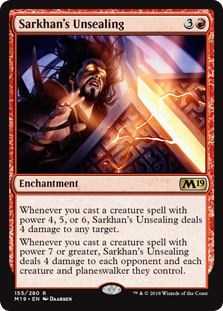 Sarkhan’s Unsealing is another card that bears more than a passing resemblance to previous Red enchantments that also dish out damage based on the size of your creatures. Namely, Where Ancients Tread and Warstorm Surge. Aside from being slightly more expensive to cast, the main difference between them and this card is that those cards trigger off of creatures entering the battlefield rather than being cast.
Sarkhan’s Unsealing is another card that bears more than a passing resemblance to previous Red enchantments that also dish out damage based on the size of your creatures. Namely, Where Ancients Tread and Warstorm Surge. Aside from being slightly more expensive to cast, the main difference between them and this card is that those cards trigger off of creatures entering the battlefield rather than being cast.
However, for Red, barring some flickering or reanimation shenanigans, the outcome is largely identical to this card’s first ability for any creature of power 6 or less.
What makes Sarkhan’s Unsealing so advantageous by contrast though is its second ability. It states that whenever you cast a creature of power 7 or higher, you generate a one-sided Flame Wave that cooks all of your opponent’s creatures and planeswalkers for 4 damage. It’s true that Red itself doesn’t have a ton of base creatures that fits this criteria (only two dozen in fact), the single Red mana cost makes it wayyyyyyy easy to mix with other color (or colorless) options.
It does require a little finesse, but the payoff is more than worth it for a color that is perennially in need of repeatable mass damage.
Number Ten: Detection Tower
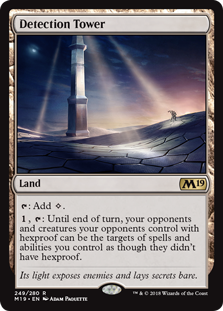 Of all the cards to make this list, few of them require as little of an explanation as Detection Tower. Mostly because this card is effectively a clone of an already existing Commander card with widespread application: Arcane Lighthouse.
Of all the cards to make this list, few of them require as little of an explanation as Detection Tower. Mostly because this card is effectively a clone of an already existing Commander card with widespread application: Arcane Lighthouse.
Heck, even the artwork is similar.
In both instances, this land allows its user to get through the protections of its opponents’ creatures so as to be able to target them. The main difference between the two cards is that Arcane Lighthouse removes both Hexproof and Shroud protections for the turn. Yet given that standard sets haven’t seen a card with Shroud printed since 2011, it wouldn’t make sense for it to be seen reprinted here, especially for a core set. Hence the new version.
In exchange, Detection Tower provides something unique of its own: stripping away Hexproof of players as well. And this can be just as, if not more useful to slot in a deck, depending on whom you play regularly. Plus, the fact that Detection Tower is in a core set means it’ll be far easier to get your hands on a copy fairly easily.
Number Nine: Poison-Tip Archer
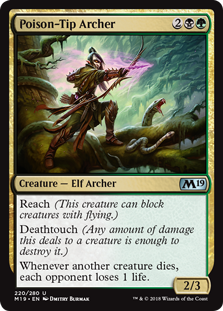 It’s a common refrain among EDH players when discussing deck construction to either brag or lament about the number of commons and uncommons their deck contains other than basic land, depending on the player’s mindset.
It’s a common refrain among EDH players when discussing deck construction to either brag or lament about the number of commons and uncommons their deck contains other than basic land, depending on the player’s mindset.
After all, one of the most appealing aspects to Commander decks is how easily it can be sometimes to simply throw many of your best cards together in a pile and make a deck around them. Commander is the epitome of multiplayer casual’s reputation as ‘Battlecruiser Magic’, where everyone is playing with big, splashy cards. And most of the time, those cards tend to be rares and mythics.
Multiplayer potential is not based on rarity, however, for what may be a lackluster ability in a duel may be an absolute beast with multiple opponents. Poison-Tip Archer is that kind of card. It may be an uncommon, but don’t let the silver icon fool you: this card can be down right devastating in the right hands. It won’t singlehandedly swing the board in your favor, but its synergy potential makes it something to sit up and take notice about all the same.
As a 2/3 Reach, Deathtouch creature for four mana, PT Archer here seems to merely be a multicolored Kessig Recluse. Not that such a comparison is bad; Kessig Recluse is a decent defensive creature on its own. Reach and and Deathtouch are a potent combination that helps protect the creature itself – and you – from haphazard attacks. In reality, though, its base abilities are more of a bonus, and not the reason it winds up being discussed here today.
The real potential to the card is its death-related trigger. It states that whenever another creature dies, each opponent loses 1 life, which can be scary to contend with in the right Commander settings – particularly those where you have a lot of sacrifice outlets at the ready or against players who love to run token armies. With this card you’re essentially trading the life syphon potential of Blood Artist (often a potent creature in its own right) for the one-sided ability to hit everyone but yourself with life loss instead. This is effective both as a massive series of triggers all at once or as a slow poison-related life drip over the course of the game.
All of a sudden things like casual board wipes have the potential to become a lot more painful.
Number Eight: Vivien Reid
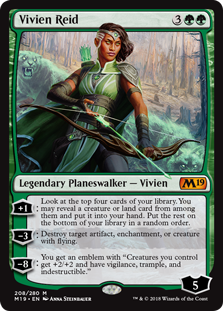
In any given set, the average number of planeswalkers has traditionally sat at around five. In the last two years, with the advent of replacing Duel Decks with introductory-level Planeswalker Decks, that number has nevertheless climbed to seven.
Between six in the base set and a whopping five unique Planeswalker Decks, Core Set 2019 has 11.
Eleven.
That’s abnormally high in general, let alone for a core set. Yet here we are. So it was statistically improbable that we not make it through a top ten set list without at least one of them bearing real Commander potential. Which brings us to the new face of Green planeswalkers, Vivien Reid.
While it’s true that most planeswalkers increase the potency of an EDH deck to varying degrees, the best planeswalkers for consideration on this list are those that have the most widespread application to the most styles of decks. These are the ones that strike the right balance between abilities, mana cost, and attainability. Sure Nicol Bolas, the Ravager is a more powerful planeswalker, but a) he’s bonkers pricey at the time of this article, and b) he requires 11 mana to be fully actualized. (Plus if you’re spending 11 mana, you sure as hell better be getting something explosive out of it.)
Versatility is the key factor here, and Vivien fits that bill easily. Five mana for a 5 loyalty planeswalker is a nice start, ensuring she doesn’t get picked off easily. (That is, unless you’re in my play group where planeswalkers often have a Kill On Sight directive.) Her first ability is a helpful topdeck tutoring, letting you grab a land or creature from the top four cards, and is more or less guaranteed card draw in Green. (If you don’t find at least one of those in your top four in Green, something has probably gone horribly wrong.)
Her second ability is very reminiscent of Freyalise, Llanowar’s Fury, who itself was on a similar list for C14. Vivien’s actually provides even more target potential in this case, letting you pick off an artifact, enchantment, or a flying creature – a nice addition both in ability and befitting her archer-based character.
And her ultimate, should you be able to pull it off, is both incredibly Green and incredibly advantageous. At its worst it provides a permanent mini-Overrun by giving your creatures +2/+2 and Trample. That alone would be enough to earn her a spot in many decks. Adding Vigilance to the mix makes that even more potent. But the real kicker to her ultimate is the bestowing of Indestructibility. Forever. As anyone who has ever stared down an indestructible board before, that is not something to be taken lightly.
What makes these combination of effects so worthwhile though is that Vivien doesn’t fit solely into one deck archetype. Her abilities are pure Green-based utility and can be beneficial whether you’re trying for combat with impunity, protection and control, or card acceleration, and she can effortlessly slide into almost any Green EDH deck without much thought.
Number Seven: Resplendent Angel
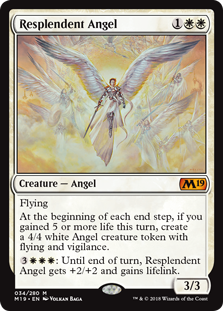
One of the hallmark traits to any modern Magic set, core or otherwise, is that the designers painstakingly include cards that cater to the plethora of different formats and play styles in circulation. Once upon a time the primary concern was simply whether it was a neat card that coherently fit into a set, but over time more an more considerations have been added. Nowadays, any standard set release – in addition to maintaining power levels, storyline concerns, and relative balance – will contain cards for Limited, Standard, Commander, and even occasional cards explicitly made with Modern in mind. It’s a lot to juggle, certainly.
Thing is, while there are many cards that are added with a specific group in mind, there is also the occasional Omnicard – a card that just about everyone can benefit from. Resplendent Angel is an Omnicard.
It doesn’t take much effort to see why. Resplendent Angel is well above curve as a 3/3 flyer for three mana, making it useful in drafts and plenty of White aggro decks. Its activated ability then ensures it won’t only be seen as an early game card, as for an admittedly expensive six mana activation, it becomes a 5/5 Flying, Lifelink creature for the turn, putting it close to Baneslayer Angel territory in terms of usefulness.
But wait, there’s more! Because Resplendent Angel also states that if you gain 5 life in a single turn, you get to create a free Serra Angel. Her activation ensures that will happen by itself, but if you have other means of gaining life then you may also be able to benefit from it without the risk of attacking…
Resplendent Angel has ubiquitous appeal, but its potential in Commander is notable because reaching a point in gameplay where a six mana activation isn’t a huge deal is far more common here than other settings. At the same time, whereas in other formats a single bonus token may be enough to swing the game, in EDH you likely may have the time and means to assemble a small army.
At its absolute worst, Resplendent Angel is a complete package unto itself, but there is a lot of synergy potential to explore with here. Its triggered effect is just begging to be built around in a manner that is hard to resist. The biggest obstacle to its use for the majority of Commander players unfortunately will be its cost, as most Omnicards tend to be pricey due to demand on multiple fronts.
Number Six: Runic Armasaur
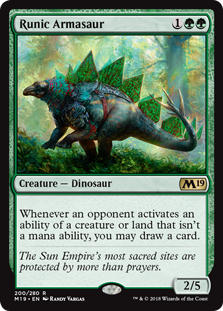
To many Standard players, the most obvious attribute about this card is that it’s an aggressively costed dinosaur, which will fit in nicely for the current Ixalan-heavy meta. Here, three mana nets you a 2/5 creature, making it a great enabler for a variety of different dino-centric strategies.
In the context of multiplayer gaming, however, all eyes are on the Runic’s ability, which states that if an opponent uses a non-mana ability of a creature or land, you can draw a card.
In the realm of EDH, this happens a lot. A real lot. Think about it: this means nearly every creature’s tap ability or static activation and nearly every utility land you can name – all of which Commander is perennially flush with – will allow you to draw a card. The sheer number of situations where you can benefit from having this simply sit on the battlefield is impressive, and there will be no shortage of decks where it will call home based on that fact alone.
You will draw cards with this creature. The real question is how long your opponents will let it sit on the battlefield letting you do so. Make no mistake, Runic Armasaur has the potential for some extensive free card advantage if left unchecked, making its only real down side the fact it’s a magnet creature for removal. Luckily its 5 toughness gives it a little extra defense to help keep it alive to that end.
It’ll probably need it.
That’s it for now! Check back in two weeks for Numbers 1-5!
![]()
Would these cards have been on your own top ten? Tell us over on our social media!
Do you have a particular Commander card to suggest for us to shine a future Spotlight on? You can send suggestions to ryan@cardboardrepublic.com
